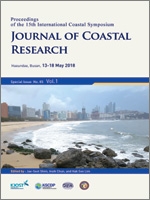Lee, W.D.; Yoo, Y.J.; Jeong, Y.M.; Jeong, Y.H., and Hur, D.S., 2018. Experimental Investigation of the Effects of Revetments on Seawater Intrusion in Coastal Aquifers. In: Shim, J.-S.; Chun, I., and Lim, H.S. (eds.), Proceedings from the International Coastal Symposium (ICS) 2018 (Busan, Republic of Korea). Journal of Coastal Research, Special Issue No. 85, pp. 441–445. Coconut Creek (Florida), ISSN 0749-0208.
Sea level rise due to global warming and the decline in groundwater levels due to the misuse of groundwater resources can decrease the seawater and groundwater pressure gradient, which can, in turn, increase seawater intrusion into coastal aquifers. Many researchers have conducted theoretical, experimental, and numerical analyses on the effects of changes in seawater and groundwater levels on coastal aquifers. In this study, modeling experiments were conducted in a sandy tank to analyze revetment and underground obstacles that influence seawater intrusion in coastal aquifers. We focused on areas that have not been examined by current research. We confirmed that as the gradient of the seawater level to groundwater level increased, seawater intrusion weakened, because the difference between the seawater and groundwater levels increased as the salinity difference between the seawater and freshwater decreased. Following the installation of a revetment in the experimental coastal aquifer, the groundwater level behind it increased. Due to a decrease in the cross-sectional area, a special seawater–freshwater interface formed. We found that the seawater–groundwater pressure gradient increased due to the revetment, the flow to the sea increased, and the seawater–freshwater boundary moved in the direction of the sea in the experimental tank. This study suggests that if revetment and similar underground obstacles are arranged appropriately, the groundwater level and groundwater flow can be changed, and seawater intrusion in coastal aquifers can be reduced. In the future, results from this experiment could be used by numerical models as verification data for the seawater–freshwater interface and the seawater intrusion distance.





